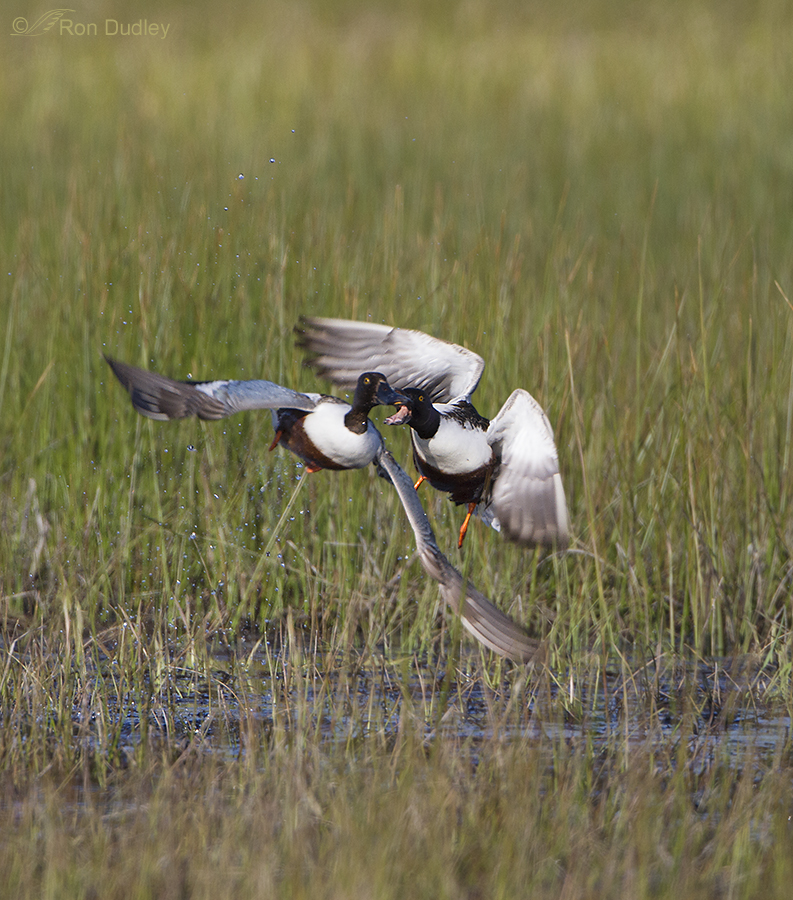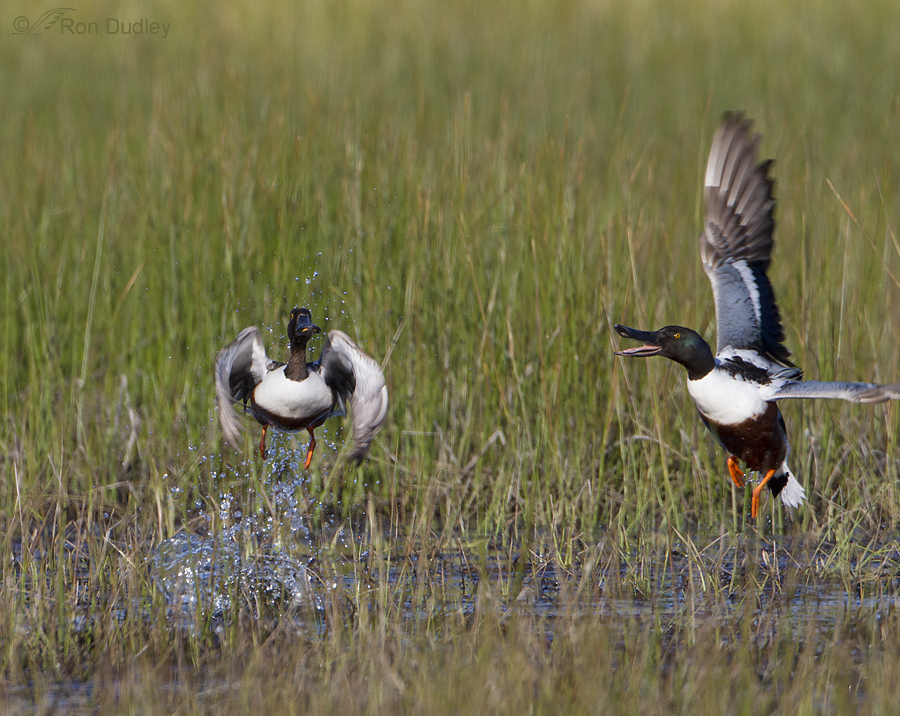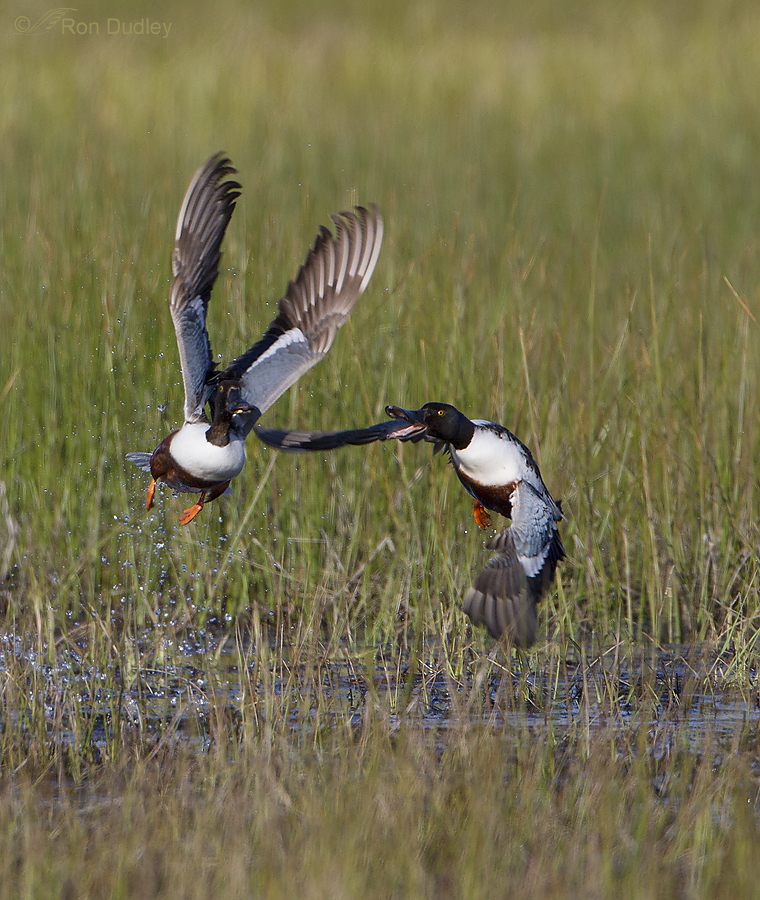Most Northern Shovelers breed far north of my area (northern Utah) so I rarely get to see their intensely agonistic breeding behaviors but I’ve seen and photographed some of it in mid-June at Red Rock Lakes National Wildlife Refuge in sw Montana.
Northern Shovelers are the most territorial of all dabbling ducks and the sexes remain paired longer than any other species. Both of these factors contribute to their aggressive natures.
These three sequential shots don’t have great image quality but I do think they illustrate some interesting behavior.
1/2000, f/7.1, ISO 500, 500 f/4, 1.4 tc
I’d been photographing Short-eared Owls from my pickup but was aware of some activity from shovelers in the marshy grasses nearby. A commotion got my attention just in time to see the male on the right fly in to attack another male on the water. The second bird saw the attack coming and decided that discretion was the better part of valor and rose from the water in a hasty retreat. I like the non-plussed look of the retreating bird.
1/2000, f/7.1, ISO 500, 500 f/4, 1.4 tc
In this second image of the series it’s not clear if the open bill of the incoming bird is due to aggressive vocalization or an attempt to bite the other male.
 1/2000, f/7.1, ISO 500, 500 f/4, 1.4 tc
1/2000, f/7.1, ISO 500, 500 f/4, 1.4 tc
But in this last image I think it becomes obvious that the intent was to bite the retreating duck.
Bird behaviors fascinate me. They’re often both interesting and entertaining but many of them happen so fast that you miss the details from simple observation. That’s why I so enjoy being able to occasionally capture them with my camera.
Ron




Once again, wonderful captures of behavior!
Love the documentation here. I wasn’t aware that Shovelers paired for longer periods than other ducks, very interesting.
We often see birds being quite aggressive over the food we put out for them. A pair going ‘beak to beak’ (with claw involvement as well) is very common. Mostly, but not always, merely sound and fury but if the weaker does not give way…
I loved your Attack of the Shoveler – and agree it would make a wonderful SF movie title…
Hi Ron, For some reason, when I saw the words “Attack Of The Shoveler” appear in my inbox, I immediately thought of a Sci-Fi horror flick (!). No punchline here, just my weird mind at work. As always, your images are wonderful and there is always a natural history factoid or two (or more) in your text. I continue to learn from your postings. Thanks!
Cheers,
Dick
Well truth be told, Dick I’ll admit that was part of my intent with the title – to be accurate but also to potentially pique some interest. Couldn’t resist…
I’m glad you enjoy the “factoids” and I appreciate the feedback on that.
Here’s a video I found of what seems a male Swan forcing a female to mate with him. The people are hysterical, and want to stop what seems to be a fight, but ends up being a “forceful” attempt to mate with her. At the end, another male arrives, and the female walks away. But the people really like to interfere with these natural events. http://www.youtube.com/watch?v=PnMualBSzKs I don’t think the female really wanted him.
Interesting behavior in the clip, Maria – from both the birds and their human observers.
Ron: I’ve hear Mute Swans have very gruesome and bloody fights. Are there Mute Swans in Utah?
Maria, As far as I’m aware there are no Mute Swans in Utah other than some that may be in captivity.
A technically superior image of wildlife (the kind you post) can be a true work of art. Capturing behavioral moments such as this one and still achieving high quality is a testament to your skill and dedication. These moments are only possible when the photographer gets “out there” a lot.
Really interesting sequence!
Thanks, Wally. Yeah, I do spend a lot of time in the field and you’re right – that increases the possibilities of seeing and capturing stuff like this.
That poor “victim” chose the wrong direction to hastily depart in, scattering sapphires all over the place! The expression in the first photo is pure Daffy Duck. How far apart in time were these shots? You mention that some behaviors like this are hard to catch on simple observation. I’m glad we have you (and all other bird photogs!) to record for us.
Chris, the Canon 7D has a burst rate of 8 frames/second and these three consecutive images were in one quick burst so the shots were taken approximatey .125 sec apart.
Wow! Camera, action, film!! These are great shots! Thanks for the spot of spring as I look outside at more snow!
Yes, I think I had good timing on subject matter for this one, Tana. I’m looking at a virtual blizzard right now so the bit of green is a nice reminder that it (theoretically) won’t be permanently white out there.
Another set of great shots. I too, like the expressions on the face of the retreating bird. Your photography allows me to feel as if I were there watching the event.
Thanks, Susan.
Hi Ron,
I really enjoy your images and I thank you for sharing. It appears we are about the same age and I have been shooting waterfowl on and off for the past 15 years and yes I have several images I am proud of but the one thing that really impresses me about your images is how tack sharp they are. I’m lucky to get one tack sharp shot out of 50 and it gets really frustrating sometimes. I feel I’m pretty good with photoshop and lightroom but I think everyone knows you have to have a good image to start with. I also use a good heavy tripod and a Wimberley head.
Would you mind giving any tips on your techniques you use to get sharp images?
Thanks
Mike
Thank you, Mike. I get my share of soft shots too. I’ll email you with a couple of questions about gear and technique first, then help if I can.
Pretty great shots! Bird fighting is always pretty amazing to see.
Thanks, Scott.